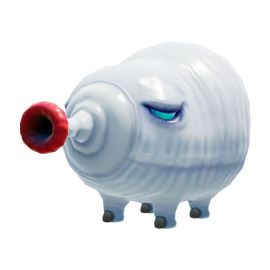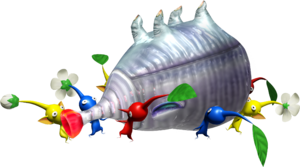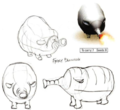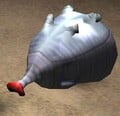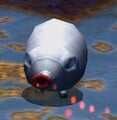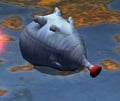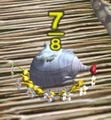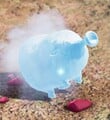Fiery Blowhog
The Fiery Blowhog (ブタドックリ?, lit.: "Pig Tokkuri") is an enemy in Pikmin, Pikmin 2, Pikmin 3, and Pikmin 4, and a boss in Hey! Pikmin. As the name would imply, Fiery Blowhogs shoot fire from their red snouts. They are only found in The Forest Navel and are larger than in the other main Pikmin games in Pikmin, but are found commonly in Pikmin 2 and Pikmin 3. Like all bosses in Hey! Pikmin, only one appears in the game, in Blazing Winds. In the first two games, when provoked by Pikmin, Fiery Blowhogs will buck them off into an area in front of them and shoot fire. In Pikmin, it can be extremely difficult to save burning Pikmin, but blowing the whistle within the area of the Blowhog's attack will ensure that any Pikmin caught in the flames will instantly be extinguished.
In Hey! Pikmin, its behavior is a quite different from the main games in the series: this beast stands on top of a pillar and shoots fire at Olimar down below. It is normally too far up to reach, but can be stunned with a bomb rock, and by sneaking to its backside, the player can throw Pikmin at the part of its body that slipped off the platform. As it is now a boss, it is much larger than in the main Pikmin games. It drops the Shimmering Skull when defeated. A younger variant can be found in this game, the Fiery Blowlet.
Fiery Blowhogs also have lightly colored segments that are barely visible in-game, but more noticeable in the creature's artwork. These became more visible in Pikmin 3 and Hey! Pikmin.
Stats[edit]
|
To do: Find out its health in Hey! Pikmin by retrieving the value from the game files. |
| Game | Weight | Max. carriers |
Seeds | Value | Health | Regen. |
|---|---|---|---|---|---|---|
| 7 | 15 | 8 | N/A | 2500 | Unknown | |
| 7 | 15 | 8 | 1000 | No | ||
| 5 | 10 (normally) | 8 | 1000 | No | ||
| 5 | 10 | 5 | 1000 | No | ||
| N/A | N/A | N/A | Unknown | Unknown |
Behavior[edit]
Fiery Blowhogs typically wander around a very small zone aimlessly – they aren't stationary, but they won't move a significant distance from their home territory. Once a Blowhog has detected the presence of a leader and/or Pikmin, it will rotate to face them, before spewing out a stream of fire. Although the Fiery Blowhog waits for an opportune moment to begin exhaling, it must inhale first, which creates a short delay before firing in which the attack may be avoided. From the moment the creature begins inhaling to the moment it's done spitting fire, it will not rotate or move, meaning the spray of fire will not follow leaders or Pikmin running away.
If the Blowhog is under attack and not currently exhaling, it will buck itself forward and immediately shoot flames in the direction it was facing, though it must still inhale first. This bucking motion occurs regardless of whether the Blowhog is being attacked by Pikmin clinging to its body or not.
In Pikmin 2, Blowhogs may not shoot fire if only a leader is present nearby. This can be seen by keeping a leader very close to the creature. Also in this game, an idle Blowhog will only turn to the left to change in which direction it wanders. When engaged in combat, however, they can also turn to the right.
Hey! Pikmin[edit]
At the start of the battle, the creature points its snout in Olimar's general direction, inhales for some seconds, and then spits a steady stream of fire, all without changing the direction of the snout. The flame attack lasts for some seconds, and after it stops, the cycle repeats. This fire, naturally, will not hurt the Red Pikmin, but will damage Olimar. It won't trigger any bomb rocks on the generator, but will trigger bomb rocks that Pikmin are carrying. The suction attack will not be strong enough to do anything to Olimar (even if he's riding his jetpack), or to Pikmin on the ground, and if Pikmin are thrown at the snout, they will squeal and get trapped in the air for a bit, but will eventually fall back down. If the player enters a doorway to go to the other side, the creature will finish its cycle, and will then turn around to face Olimar before it starts a new cycle.
If while it's inhaling, a bomb Rock Pikmin is thrown at the snout, the Pikmin will let go of the bomb, and the Blowhog will inhale it. It will only catch one bomb rock, so if more bomb-carrying Pikmin are thrown, they will just drop their explosives in the air. The rock is too big to go inside the snout, so it gets stuck at the entrance for a second before it explodes. When it does, the Fiery Blowhog gets thrown back and starts hanging from the ledge it's on, with its backside dangling, and at the reach of Pikmin. It will stay this way for some seconds, until eventually it climbs back up, jumps on its platform, and causes boulders to fall in random places, but near the center of the arena.
If its health reaches two thirds while it's dangling, it will shake the Pikmin off, get back up, and jump on the platform to cause boulders to fall like before. But this will also signal some changes in its attack pattern: at the start of the cycle, it will inhale for only a split-second, and will then spit three fire balls. It will change direction slightly to face Olimar each time it shoots a fire ball. After that, it will perform the usual long inhale, followed by the stream of fire, but will also slowly turn its snout to Olimar as it expels fire. If the player goes to the other side of the area while the beast is spitting balls of fire, it will stop, turn around, and will restart the cycle by quickly inhaling and spitting three balls of fire again. To note is that the quick inhale cannot capture bomb rocks, and that the fire balls can ignite bomb rocks, whether they are on the generators, or in the hands of a Pikmin.
Like before, if it is health reaches the last third while it's dangling, it will shake the Pikmin off, climb back up, and jump to summon boulders, but will change its attack pattern once more. From here on out, the quick inhale will be followed by three volleys of three fire balls each. The fire balls spread out, each following its own angle, and once again, the creature will slightly change direction each time it exhales. After that comes the long inhale and stream of fire, except it will rotate even faster when it spits out the stream.
Locations[edit]
Strategy[edit]
|
The following article or section contains guides. |
Pikmin[edit]
Red Pikmin are recommended, but if you're careful, it can be taken out with any type of Pikmin. To start off, throw a single Pikmin directly onto the Fiery Blowhog (preferably a leaf Pikmin so it doesn't get deflowered). Immediately after the Blowhog throws the Pikmin off, swarm it with the entire group. If it is evident that it will survive this attack, call back the Pikmin swarming it before they can get knocked off, then re-swarm the Blowhog. Repeat until it's dead. Pikmin that are swarming a Fiery Blowhog cannot be ignited, meaning they're safe from its attack. You could also leave a group of Reds near a Fiery Blowhog, (recommended leaf), and they cannot be killed, unless the Fiery Blowhog bucks them into water. Make sure you make the Blowhog faces away from any water sources.
Pikmin 2[edit]
The same strategy described above works equally well here and since they are easier to kill in Pikmin 2, a large Pikmin group can swarm it right away for the kill. Obviously, throwing Purple Pikmin on it will deal serious damage to the Blowhog, as well as rendering unable to buck the Pikmin off, or breathe fire.
Pikmin 3[edit]
The strategy described for the first game works just fine still, only you don't need to take as much caution, since Pikmin cannot be deflowered by the bucking attack now. This means that unless a Blowhog can potentially buck them into water, it poses virtually no threat to Red Pikmin. Henceforth, to save time, its easy to just leave a small group of Red Pikmin attack a Fiery Blowhog, go off and accomplish some other task, and by the time you return, the creature should be dead, and all your Pikmin should be fine. Or if you have a large army of Red Pikmin, just send them all charging at the creature and it will be dead within a few seconds. If it manages to buck them all off, just whistle them back and repeat the process. You can be particularly careless if you've obtained the Scorch Guard upgrade, prevent your leaders from being damaged by the fire.
If no Red Pikmin are available, take caution and attack from the rear. Whistle the Pikmin off every time the Blowhog begins to buck and repeat the process to take it out without much of a problem. If any clovers are nearby, this process becomes even easier, and you can lose its attention to get a shot at the rear.
Hey! Pikmin[edit]
Start by luring the Blowhog into inhaling near the center of the arena. While it's inhaling and spitting fire, it will not turn to you, so take this time to grab a bomb rock. When it begins inhaling again, throw a bomb rock at the snout. If its fire touches the bomb rock, the Pikmin holding on will let it go, and the timer will start counting down, so beware. As soon as you throw the bomb rock, enter a doorway to go to the other side of the stage, and quickly throw Pikmin at its backside. If you're quick, the creature's health will freeze at the two thirds mark, and it will shake the Pikmin off, but if not, you'll have to repeat the cycle until that happens. Every time it climbs back up, it will jump on its platform and cause boulders to fall, but these can be easily avoided by standing near the edges of the arena.
Once its health is at two thirds or less, it will start each cycle by inhaling quickly and shooting three fire balls. Dodge each one, and try to obtain a bomb rock during this time, but don't swap sides, since that will just cause the creature to turn around and restart the fire ball sequence. Afterwards, it will do the long inhale and spit a stream of fire, but this time, it will slowly turn to you. Throw the bomb rock at its snout while it's still inhaling, like before, but if you can't, escape from the stream however you can, even if you have to enter doorways.
Just like before, this pattern will be repeated until you get its health down to the last third. From here on out, when it does the quick inhale, it will shoot 3 volleys of 3 fire balls each, which spread out. These fire balls aren't particularly hard to dodge as Olimar, but it is very difficult to avoid having a bomb-carrying Pikmin touch one. As such, you should try to obtain a bomb rock right after it shoots out its third volley. To make sure that you have enough time and space to get a bomb rock, go on one corner of the arena at the start of the cycle, lure it into shooting the first volley near that edge of the arena, and by the time it starts the second, race to the opposite end. The Blowhog will not turn enough to shoot the final three fire balls at the other corner of the arena, giving you enough time to grab a bomb rock, and to get ready to throw it during the long inhale attack. If you couldn't, and the creature ended up launching fire, know that it will follow Olimar even faster, perhaps making it impossible to dodge by simply running to one side of the arena. Enter a doorway to escape, if you must.
If you want to be quick, as soon as the boss battle begins, run to the left and get a bomb rock. The creature should be turning to face you just as the Pikmin returns to you, so quickly throw the bomb rock Pikmin at its snout, since it will start inhaling very quickly. Afterwards, just make sure to have a bomb rock ready every time it starts the long inhale attack. Use the strategies in the previous paragraphs to help make sure the bomb rock isn't dropped during the other attacks.
To note is that the bomb rock explosions cannot reach the creature when it's dangling.
Biology[edit]
The Fiery Blowhog's physiology is quite mammalian, with its rubbery hide and even elephant-like appearance. It also somewhat resembles a hog, which is emphasized by its name.
According to Olimar's notes, the Fiery Blowhog expels fire using an unknown phosphorous compound that ignites as soon as it touches the air. In real life, phosphorous is a highly reactive element, and is used in explosive and fiery material artificially, such as in matches and bombs. Because Olimar specifically states this chemical ignites when it contacts air, the compound is probably white phosphorous, which spontaneously combusts in moist oxygen. This seems to line up with the Fiery Blowhog's behavior, and the element is even an organic element in real life, but is used in completely different ways.
It is hinted by the Watery Blowhog's notes that this compound takes the form of a flammable liquid. An orange liquid can also be seen dripping from its snout after breathing fire in that game, so it's possible that is the liquid Olimar is referring to. Although in reality phosphorous is never orange, and at the closest red, this will be explained later. Putting these two together, the creature may shoot out some form of liquid phosphorus. However, to fit with the previous assumption of it being white phosphorous, it would make more sense if it is an unknown liquid that contains many small bits of white phosphorous, since white phosphorous can only be solid. The orange liquid dripping of its snout may be remaining liquid that didn't have enough phosphorous to ignite, or the phosphorous in that liquid has already ignited.
Additionally, Watery Blowhogs are said not to contain the dominant genes necessary to produce the chemical, hinting that they don't have the white phosphorous required to breathe fire. The clear liquid they shoot is likely the same liquid the phosphorous flows in in Fiery Blowhogs, but it is still unknown what it really is, and why it changes from orange to clear.
Because it contains such explosive materials and processes in its body, Olimar warns in his notes that it may explode when dead, as it becomes unstable. No such behavior is seen in-game though, even after it is killed, so Olimar has probably just speculated this. The reason why it can't explode may be the same reason why Louie mentions it is inflammable, and there could be a complex process preventing this that has yet to be explained in the games.
Notes
Olimar's voyage log
Reel notes
Olimar's notes
Louie's notes
Alph's comments
“Structural flaw: inhaling period
Weight: 5
Brittany's comments
Charlie's comments
Louie's comments
Olimar's comments
“Fiery Blowhog
Sus draconus
Blowhog family
Hey! Pikmin logs
Dalmo's notes[edit]
Olimar's notes (Pikmin 4)[edit]
“This creature expels a volatile phosphorus compound from its snout that combusts upon contact with air. This fire-breathing ability is dependent upon the air-to-fuel ratio at its mouth, catalyst reaction within the expelled compound, and purification of the compound.
Thus it is highly unlikely such a complex process could cause the spontaneous explosion of a fallen Blowhog. (This process is also perhaps to avoid risk of spontaneous combustion in the belly of a live specimen.)
However, one should still treat a Fiery Blowhog with great care during transfer.”Louie's notes (Pikmin 4)[edit]
Pikmin Nintendo Player's Guide[edit]
Pikmin Nintendo Power booklet description[edit]
Pikmin Book[edit]
Text
| 通称 | ブタドックリ |
| 和名 | ヒフキブタドックリ |
| 分類 | ブタドックリ科 |
| 倒したとき | 死ガイ |
| 運搬に必要な数 | 7〜15 |
| 生まれるタネ | 8 |
| 弱点 | 背中(呼吸時・火炎放射時に大ダメージ) |
| 攻撃方法 | 火炎放射 |
| 振り払い | 通常(正面) |
| 移動方法 | 歩行 |
| おもな自生エリア | 樹海のヘソ |
“体の前方にある口から、常温空気中で発火するリン化合物を吐くかなり危険な生物。吐き出す発火物質は触媒との反応や混合比など、精製プロセスが非常に複雑なため(炎の逆流や体内での発火といったリスクを回避するためと思われる)、生命活動が停止しても勝手に発火することがないようになっている。それでも死ガイの扱いには十分注意する必要がある。
- (Image text:
- ↑火に強い赤ピクミン以外のピクミンは燃やされてしまうので注意しよう。)”
Translation
| Nickname | Fiery Blowhog |
| Japanese name | Fire Breathing Pig Tokkuri |
| Classification | Blowhog family |
| When defeated | Carcass |
| Number required for transport | 7-15 |
| Seeds produced | 8 |
| Weak point | Back (Major damage when breathing fire or emitting flames) |
| Attack method | Flamethrower |
| Shaking off | Normal (Front) |
| Movement method | Walking |
| Main habitat area | The Forest Navel |
“A highly dangerous creature that spits out phosphorous compounds from its mouth at the front of its body, which ignites in ambient air. The expelled ignition substances are designed to not spontaneously ignite even after life functions cease, due to the highly complex purification process involving reactions with catalysts and mixing ratios (presumably to avoid risks like flame backflow or ignition within the body). Nevertheless, extreme caution is required when handling the corpse.
- (Image text:
- ↑Be careful, as all Pikmin other than the fire-resistant Red Pikmin will get burned.)”
Pikmin 2 Nintendo Player's Guide[edit]
“Among the most common creatures in the Pikmin 2 landscape are the groundbased Blowhogs, both Fiery and Watery. You can distinguish the Fiery Blowhogs by the red markings at the end of their snouts and by the flames that they spit at your leaders and troops. Attack their backs with red Pikmin.”
New Play Control! Pikmin European website[edit]
“Some spouts are used to put out fires, a Fiery Blowhog’s snout starts them. This beast has a lot of love to give, to things that love fire. It can shake Pikmin off its back and then blast them with a stream of fire from his nose. A similar breed of Blowhog puffs out air.”
Pikmin 3 Prima Guide[edit]
“A Fiery Blowhog attacks by shooting flames out of its snout. When you encounter a Fiery Blowhog, use your Red Pikmin to attack the creature without suffering any casualties. If your squad contains only a small amount of Red Pikmin, use them to distract the Fiery Blowhog, then flank the creature and have your more vulnerable Pikmin charge from the rear.”
Pikmin Garden[edit]
Text
“4本足のトックリ状の体に、鼻と口が一体化した口吻を持ち、縄張りに入ってきた獲物や外敵に火を吹く生物。鼻を鳴らしたような声は、仲間との意思疎通に用いられる。
特徴 その1 火を吹く
- 直接火を吹いているのではなく、吐き出したリン化合物が常温空気中で発火している。
- (Image text: 炎の逆流や体内での発火は起こらない)
特徴 その2 仲間が多い
- ブタドックリ科の生物は数や種類ともに多く、多様性に富んでいる”
Translation
“A creature with a four-legged, tokkuri-like body and whose nose and mouth are combined into a snout, it breathes fire at prey or enemies that enter its territory. Its snorting vocalizations are used to communicate with its mates.
Feature #1 Fire-breathing
- It does not breathe fire directly, but rather, it spits out a phosphorous compound that ignites in room temperature air.
- (Image text: "There is no flame backflow or ignition inside the body")
Feature #2: Many relatives
- Creatures in the Blowhog family are very diverse in both number and variety.”
Other Games[edit]
In Super Smash Bros. Brawl[edit]
The Fiery Blowhog appears as a trophy in Super Smash Bros. Brawl.
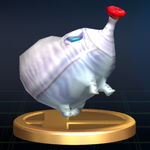
|
Description:
“A member of the blowhog family characterized by its bottle-shaped body and slow, lumbering movement. Skillful in the use of its red snout and able to violently shake off Pikmin, the fiery blowhog is also capable of spitting a volatile phosphorus compound that combusts on contact with air, threatening nearby enemies. | |
| How to obtain: Random appearance. | Type: Fighter Related | |
In Super Smash Bros. Ultimate[edit]
The Fiery Blowhog appears as a primary Spirit in Super Smash Bros. Ultimate.
| Spirit info | Augmented Fighter info | ||||||||
|---|---|---|---|---|---|---|---|---|---|
| Name | Type | Class | Slots | Fighter(s) | Stage | Music | Rules/Hazards | Conditions | Image |
| Fiery Blowhog | Attack | ★ | 1 | Charizard (×3) | The Great Cave Offensive (Battlefield Form) | Mission Mode - Pikmin 3 (Remix) | • Item: Fire Flower | • Stamina battle • The enemy favors neutral specials |
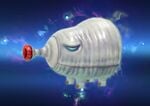
|
Technical information[edit]
| Pikmin technical information (?) | |||
|---|---|---|---|
| Internal name | tank
| ||
| HP | 2500 | ||
| Pikmin 2 technical information (?) | |||
|---|---|---|---|
| Internal name | tank
| ||
| Global properties (List) | |||
| ID | Japanese comment | Property | Value |
| s000 | friction(not used) | Friction | 0.5 |
| s001 | wallReflection | Unknown (wall bounce speed multiplier?) | 0.5 |
| s002 | faceDirAdjust | Unknown | 0.25 |
| s003 | accel | Acceleration | 0.1 |
| s004 | bounceFactor | Unknown (bounce when it hits the ground?) | 0.3 |
| fp00 | ライフ | HP | 1000 |
| fp01 | マップとの当り | Unknown (related to slopes) | 25 |
| fp02 | ダメージスケールXZ | Horizontal damage scale | 0.35 |
| fp03 | ダメージスケールY | Vertical damage scale | 0.25 |
| fp04 | ダメージフレーム | Damage scale duration | 0.35 |
| fp05 | 質量 | Unknown (weight?) | 0.0001 |
| fp06 | 速度 | Move speed | 80 |
| fp08 | 回転速度率 | Rotation acceleration | 0.05 |
| fp09 | テリトリー | Territory radius | 150 |
| fp10 | ホーム範囲 | "Home" radius | 1 |
| fp11 | プライベート距離 | "Private" radius | 75 |
| fp12 | 視界距離 | Sight radius | 200 |
| fp13 | 視界角度 | FOV | 90 |
| fp14 | 探索距離 | Unknown (exploration radius?) | 0 |
| fp15 | 探索角度 | Unknown (exploration angle?) | 0 |
| fp16 | 振り払い率 | Successful shake rate | 1 |
| fp17 | 振り払い力 | Shake knockback | 400 |
| fp18 | 振り払いダメージ | Shake damage | 1 |
| fp19 | 振り払い範囲 | Shake range | 30 |
| fp20 | 攻撃可能範囲 | Unknown (shock attack max range?) | 120 |
| fp21 | 攻撃可能角度 | Unknown (shock attack max angle?) | 0 |
| fp22 | 攻撃ヒット範囲 | Unknown (attack hit range?) | 25 |
| fp23 | 攻撃ヒット角度 | Unknown (attack hit angle?) | 0 |
| fp24 | 攻撃力 | Attack damage | 10 |
| fp25 | 視界高 | Unknown (height visibility?) | 100 |
| fp26 | 探索高 | Unknown (exploration height?) | 0 |
| fp27 | ライフの高さ | HP wheel height | 50 |
| fp28 | 回転最大速度 | Rotation speed | 5 |
| fp29 | 警戒時間 | Unknown (warning time?) | 15 |
| fp30 | 警戒ライフ | Unknown | 100 |
| fp31 | ライフ回復率 | Regeneration rate | 0 |
| fp32 | LOD半径 | Off-camera radius | 45 |
| fp33 | マップとのあたりポリゴンの選定 | Collision processing radius | 40 |
| fp34 | ピクミンとのあたり | Pikmin damage radius | 15 |
| fp35 | 石化時間 | Petrification duration | 1 |
| fp36 | ヒップドロップダメージ | Purple Pikmin drop damage | 50 |
| fp37 | 地震気絶確立 | Purple Pikmin stun chance | 0.3 (30%) |
| fp38 | 地震気絶時間 | Purple Pikmin stun time | 10 |
| ip01 | 振り払い打撃A | Shake mode 1 – hit count | 3 |
| ip02 | 振り払い張付1 | Shake mode 1 – Pikmin requirement | 2 |
| ip03 | 振り払い打撃B | Shake mode 2 – hit count | 3 |
| ip04 | 振り払い張付2 | Shake mode 2 – Pikmin requirement | 5 |
| ip05 | 振り払い打撃C | Shake mode 3 – hit count | 3 |
| ip06 | 振り払い張付3 | Shake mode 3 – Pikmin requirement | 10 |
| ip07 | 振り払い打撃D | Shake mode 4 – hit count | 3 |
| Specific properties | |||
| None | |||
| Pikmin 3 technical information (?) | |
|---|---|
| Internal name | tank
|
| HP | 1000 |
| Rock Pikmin throw hits to kill | 30 |
| White Pikmin ingestions to kill | 0 |
| Bomb rock explosions to kill | 1 |
| Bomb rock ingestions to kill | 0 |
| Number of direct hits on top to kill | 0 |
| Damage to leaders | 10 |
| Territory radius | 150 |
| Mission Mode value | 30 |
Other information[edit]
- Technical name in The Official Nintendo Player's Guide: Porciferno
- Size: Body length: 52mm, as per the e-card
- Pikmin 2 Piklopedia number: #13
- Pikmin 4 Piklopedia number: #17
Naming[edit]
- See more: Blowhog family#Naming.
- Common name: Fiery Blowhog. The word "Fiery" is, of course, due to its ability to spit out fire.
- Japanese nickname: ブタドックリ?, lit.: "Pig Tokkuri". The "Pig" part comes from its body shape and the sounds it makes.
- Japanese name: ヒフキブタドックリ?, lit.: "Fire Breathing Pig Tokkuri".
- Scientific name: Sus draconus, which is Latin for "pig dragon".
- Internal names: The creature is internally called
tankin the main games, likely because of its slow moving and fiery qualities. In Hey! Pikmin, it is instead calledbutadokuri, which is the Japanese Romanization of its name. Its generator name is alsoboss_flame_throw, obviously referring to its flame spitting abilities. - Prerelease: None.
Names in other languages[edit]
| Language | Name | Meaning | Notes |
|---|---|---|---|
| ブタドックリ? Buta Dokkuri |
Pig Tokkuri | Tokkuri | |
(traditional) |
豬德古利 Zhū Dégǔlì |
Pig Tokkuri | |
(simplified) |
猪德古利 Zhū Dégǔlì |
Pig Tokkuri | |
| Vurige Blowhog[1] Vlammend snuitzwijn (Pikmin 4) |
Fiery Blowhog Flaming snoutswine (Pikmin 4) |
Name taken from NEW PLAY CONTROL! Pikmin website Name taken from Pikmin 4 | |
| Crachefeu (Pikmin) Puffy Crachefeu Puffy crachefeu (Hey! Pikmin, Pikmin 4) |
Fire-spitter (Pikmin) Fire-spitter Puffy Fire-spitter puffy (Hey! Pikmin, Pikmin 4) |
"Crachefeu" is a combination of "crache" (spit) and "feu" (fire) | |
| Rüsselignis | Trunk-Ignis | The name is a combination of German "Rüssel" (trunk/proboscis) and Latin "ignis" (fire) | |
| Eruptor igneo | Fiery eruptor | ||
| 돼지호롱 Dwaeji-Horong |
Pig Oil Lamp | ||
| Cusporco-dragão | Dragon spitpig | "Cusporco" is a portmanteau of "cuspir" (to spit) and "porco" (pig) Even though "dragão" means 'dragon', the "Cusporco-dragão" (Fiery Blowhog), uses the word as an allusion of a fire-breathing dragon | |
| Verraco dragón | Dragon pig | Even though "dragón" means 'dragon', the "Verraco dragón" (Fiery Blowhog), uses the word as an equivalent to 'fiery' in the English name |
Gallery[edit]
Pikmin[edit]
A Fiery Blowhog spewing fire at Red Pikmin in The Forest Navel.
A group of Red Pikmin carrying a Fiery Blowhog's corpse and Olimar with a squad of mostly Red Pikmin passing by a Fiery Blowhog on their way towards The Forest Navel's landing site.
The Fiery Blowhog in the enemy reel.
Pikmin 2[edit]
The Piklopedia icon of the Fiery Blowhog in the Nintendo Switch version of Pikmin 2.
Pikmin 3[edit]
A Fiery Blowhog under the glow of some Common Glowcaps.
Screenshot of Alph attacking a lone Fiery Blowhog with a squad of Red Pikmin.
A Fiery Blowhog with a data file in the background.
Two Fiery Blowhogs in a prerelease version of Pikmin 3.
Pikmin 4[edit]
A render of a Fiery Blowhog from the Pikmin Garden Piklopedia.
Render of a Fiery Blowhog alongside other blowhogs.
Two Fiery Blowhogs on a Sizzling Floor in Below-Grade Discotheque.
A Fiery Blowhog falling onto the player in Engulfed Castle.
Two defeated Fiery Blowhogs in the Piklopedia.
Hey! Pikmin[edit]
In the Creature Log.
Other[edit]
The Fiery Blowhog's e-card, #15 (4th red card).
Trivia[edit]
- Fiery and Watery Blowhogs are one of the few Pikmin enemies to have a figurine modeled after them.
- Fiery Blowhogs are one of the enemies that can be rolled on the roulette wheel in 2-Player Battle.
See also[edit]
| Bosses | |
|---|---|
| Pikmin | |
| Pikmin 2 | |
| Pikmin 3 | |
| Pikmin 4 | |
| Hey! Pikmin | |
| Pikmin enemies |
|---|
| Pikmin 2 enemies |
|---|
| Pikmin 3 enemies |
|---|
| Pikmin 4 enemies |
|---|
| Hey! Pikmin enemies |
|---|
- Pikmin 1
- Pikmin 2
- Pikmin 3
- Pikmin 4
- Hey! Pikmin
- Blowhog family
- Pikmin 1 enemies
- Pikmin 2 enemies
- Pikmin 3 enemies
- Pikmin 4 enemies
- Hey! Pikmin enemies
- Bosses
- Fire enemies
- The Forest Navel
- Valley of Repose
- Perplexing Pool
- Wistful Wild
- White Flower Garden
- Shower Room
- Submerged Castle
- Cavern of Chaos
- Hole of Heroes
- Dream Den
- Tropical Wilds
- Garden of Hope
- Distant Tundra
- Sun-Speckled Terrace
- Crackling Cauldron
- Drafty Gallery
- Below-Grade Discotheque
- Engulfed Castle
- Seafloor Resort
- Frozen Inferno
- Sweltering Parchlands
- Super Smash Bros. series
- Pikmin 1 Challenge Mode
- Pikmin 2 Challenge Mode
- 2-Player Battle
- Mission Mode
- Side Stories
- Bingo Battle
- Dandori Challenge
- Dandori Battle
- Trial of the Sage Leaf
- Hey! Pikmin bosses
